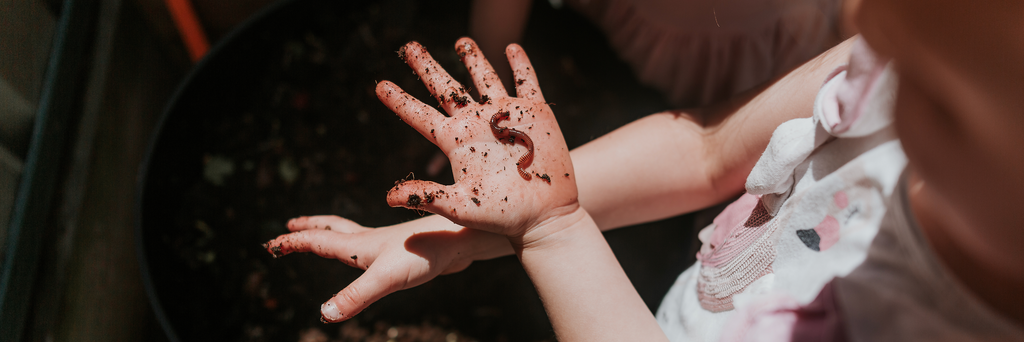< See more articles >
Involving Kids in Composting
Written by Angus Stewart
Many of the things we learn at a young age are carried with us through the rest of our lives. Simple life lessons such as looking before crossing the road, washing your hands before eating, how to tie shoe laces and putting rubbish into the bin, just to name a few.
If we can teach children that biodegradable waste goes into the compost or a worm farm, where it can return valuable nutrients into the soil and not be locked up in landfill, then it is likely this practice will continue on into adulthood. This article aims to give you some practical and fun ways to involve children in the composting process and get them excited about it too. In doing so, we can also help get them inspired to taste and eat lots of different fruits and vegetables.
If you own a composting unit or a worm farm and are using it to dispose kitchen scraps and other biodegradable waste, you are already providing your children with a real life demonstration of how it’s done. The saying “monkey see, monkey do” is very relevant here as children pick up so much just by watching and learning from their parents/carers actions.

Many households that compost and/or worm farm have a separate bucket, container or bin where biodegradable waste is put. When this is full, it goes out to the compost or worm farm and is emptied. Consider placing the composting bucket where the children can reach it and encourage them to think about things before they throw them out. Is my item compostable? If so, let’s put it in the composting container. Is it not compostable? Then what happens to it once leaves the home? These are great questions to encourage your child to think about.
It can be helpful to give your child some ownership over the composting container where household biodegradable are stored before going out to the worm farm or compost bin. When children feel empowered, they are more likely to become actively engaged and interested. Ask them to make a label for the container and maybe also draw a picture for it and stick it on. If you have more than one child, you could give them each a container. Encourage them to decorate in any way they want to. Label it with their name and inspire them to fill it as fast as they can. The more fruits and vegetables they eat, the more scraps they have and the faster their bucket will fill! Talk to your child about what the healthy food is doing for their body. Encourage them to also collect carbon rich materials for their buckets. Things like toilet rolls, used paper towels, scrap paper or dried leaves.
If you have enough space, you could even consider giving the children their very own worm farm, or even their own garden bed with an in ground worm farm in it. Ask them to think about what they would like to grow in their garden bed. A great way to encourage children to eat more vegetables is to involve them in the growing process. If the children have had a hand in selecting the edible produce, planting the seeds and seedlings and helping take care of them, they will usually be very excited to taste the produce once it’s ready, especially if they have been given ownership over it. They can then return any scraps from their home grown edible produce (such as pea pods, stems, stalks etc) to the worm farm in their own garden bed, which will then help to nourish and feed the next crop. From garden to plate and then back to the garden again!

If you don’t have the space or time needed to create a garden bed with your child, you could consider just a single plant in a pot to call their own. Your child can still compost/worm farm their kitchen scraps and use the liquid, castings and/or aged compost to feed and boost their own plant. Children usually love pouring water through a watering can, so why not invite them out to the worm farm to pour some water through it and collect the liquid fertiliser that comes out the bottom. Show them how to use this liquid to feed their plant.
Encourage your child or children as often as you can to come outside and observe the worms and the way they interact with the scraps. If your children are willing, they could even hold the worms and look at them with a magnifying glass. These hands on learning experiences are ones which children will remember and also ones that help consolidate learning. Let’s have some fun and get our hands dirty!
Happy composting.







